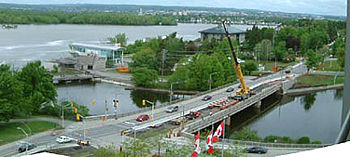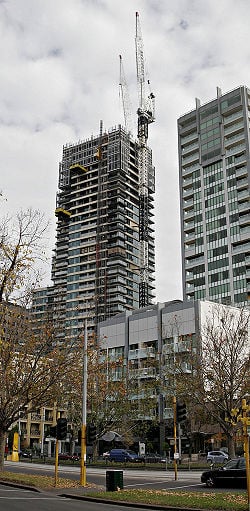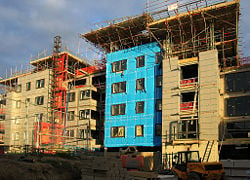Construction
- For other uses, see Construction (disambiguation).
In architecture and civil engineering, construction is the building or assembly of any infrastructure as well as the application of finishes and material conditions to create a desired physical environment. Each construction project is a feat of multitasking, involving people with many skilled trades. The project normally requires laborers, carpenters, and other tradesmen to perform the physical tasks, and the job is managed by a construction manager, supervised by a project manager, and approved by a design engineer or project architect.
To successfully execute a project, effective planning is essential. Those involved with the design and execution of the project must know how to handle such areas as scheduling, budgeting, site safety codes, and preparation of tender documents. In addition, they must consider such factors as construction delays, possible inconveniences to the public, environmental impact, and effects of the project on surrounding businesses.
In general, there are three types of construction: (1) building, (2) heavy/highway, and (3) industrial. Each type requires a unique team to plan, design, and construct the project.
Common elements of construction

Building construction is the process of adding structure to real property. The vast majority of building construction projects are small renovations, such as the addition of a room or renovation of some rooms of an existing building. The property owner often acts as laborer, paymaster, and designer for the entire project.
All building construction projects include some elements in common, including design, financial, and legal considerations. Not infrequently, projects of varying sizes produce undesirable end results, such as cost overruns and structural collapse. The problems, which may lead to litigation, may be based on inadequate planning or the tendency of hired contractors to use insufficient materials to save on costs. For this reason, professionals with experience in the field produce detailed plans and maintain careful oversight during the project to ensure a positive outcome. Many states and jurisdictions have stringent codes for the use of materials, clearances, and egress lanes to maintain fire safety and protect lives.
For large or unusual projects, the owner may establish a team of workers and specialists to create an overall plan. This ensures that the project will proceed in an orderly manner toward a desirable end. Although each project has its own needs, the requirements frequently include the work of architects, engineers, mortgage bankers, accountants, lawyers, and insurance brokers.
The design, finance, and legal aspects of a project overlap and interrelate. The design of a structure must ensure that it is structurally sound and appropriate for use, and that it is financially possible to build and legal to use. The financial plan must accommodate the need to build the design provided, taking into account amounts that are legally owed. The legal dimension must integrate the design into the surrounding legal framework, taking into consideration the financial consequences of the construction process.
Different types of construction
Residential construction
More and more families are looking into building their own homes, or contracting to have them built. Construction practices, technologies, and resources are making home construction significantly easier to accomplish. In practice, a general contractor works closely with the owners to determine their exact needs and desires, and acts as an intermediary between the owner and the sub-contractors.
Heavy/Highway construction
Heavy/Highway construction is the process of adding infrastructure to the environment we build. As in building construction, there are design, financial, and legal considerations. These projects, however, are not usually undertaken for-profit, but to service the public interest. The projects are usually owned and executed by government agencies, at the national or local level.
There are, however, many instances where such projects are undertaken by large private corporations, including owners of golf courses, harbors, power companies, railroads, and mines. They undertake the construction of access roads, dams, railroads, general site grading, and massive earthwork projects. As in building construction, the owner assembles a team to create an overall plan to ensure that the project's goals are met.
Industrial construction
Industrial construction, though a relatively small part of the entire construction industry, is a very important component. Owners of these projects are usually large, for-profit, industrial corporations, including companies involved in power generation and the manufacture of chemicals, commodities, pharmaceuticals, and so forth. The processes used by these industries require highly specialized expertise in planning, design, and construction. As in building and heavy/highway construction, this type of construction requires a team of trained individuals to ensure successful completion of each project.
Design team
In the modern industrialized world, construction usually involves the translation of paper- or computer-based designs into reality. A formal design team may be assembled to plan the physical proceedings and to integrate those proceedings with the other aspects.
The design of a construction project usually consists of drawings and specifications prepared by a design team that includes architects, interior designers, civil engineers, cost engineers (or quantity surveyors), mechanical engineers, electrical engineers, and structural engineers. The team is most commonly employed by (that is, in contract with) the property owner.
Once the design is completed, a number of construction companies or construction management companies may be asked to offer bids for the work. After evaluating the bids, the owner typically awards a contract to the lowest responsible bidder.
The modern trend in design is toward integration of previously separated specialties, especially among large firms. In the past, architects, interior designers, engineers, developers, construction managers, and general contractors were more likely to be part of entirely separate companies, even in larger firms. Currently, a company that is nominally called an "architecture" or "construction management" firm may employ experts from all related fields, or partner with associated companies that provide each necessary skill. Thus, each such firm may offer itself as "one-stop shopping" for a construction project, from beginning to end. This approach leads to a "design-build" contract, in which the contractor is given a performance specification and must undertake the project from design to construction, while adhering to the performance specifications.
The increasing complexity of construction projects creates the need for design professionals trained in all phases of the project's life-cycle. In addition, it helps develop an appreciation of the building as an advanced technological system requiring close integration of many sub-systems and their individual components, including sustainability. Building engineering is an emerging discipline that attempts to meet this new challenge.
Financial advisors
Many construction projects suffer from preventable financial problems. Underbids ask for too little money to complete the project. Cash flow problems exist when the present amount of funding cannot cover the current costs for labor and materials, and because they are a matter of having sufficient funds at a specific time, can arise even when the overall total is enough. Fraud is a problem in many fields, but is notoriously prevalent in the construction field. Financial planning for the project is intended to ensure that a solid plan, with adequate safeguards and contingency plans, is in place before the project is started, and is required to ensure that the plan is properly executed over the life of the project.
Mortgage bankers, accountants, and cost engineers are likely participants in creating an overall plan for the financial management of the building construction project. The presence of the mortgage banker is highly likely even in relatively small projects, since the owner's equity in the property is the most obvious source of funding for a building project. Accountants act to study the expected monetary flow over the life of the project, and to monitor the payouts throughout the process. Cost engineers apply expertise to relate the work and materials involved to a proper valuation.
Large projects can involve highly complex financial plans. As portions of a project are completed, they may be sold, supplanting one lender or owner for another, while the logistical requirements of having the right trades and materials available for each stage of the building construction project carries forward.
Legal considerations
A construction project must fit into the legal framework governing the property. These include governmental regulations on the use of property, and obligations that are created in the process of construction.
The project must adhere to zoning and building code requirements. Constructing a project that fails to adhere to codes will not benefit the owner. Some legal requirements come from malum in se considerations, or the desire to prevent things that are indisputably bad - bridge collapses or explosions. Other legal requirements come from malum prohibitum considerations, or things that are a matter of custom or expectation, such as isolating businesses to a business district and residences to a residential district. An attorney may seek changes or exemptions in the law governing the land where the building will be built, either by arguing that a rule is inapplicable (the bridge design won't collapse), or that the custom is no longer needed (acceptance of live-work spaces has grown in the community).
Also, a construction project is a complex net of contracts and other legal obligations, each of which must be carefully considered. A contract is the exchange of a set of obligations between two or more parties, but it is not so simple a matter as trying to get the other side to agree to as much as possible in exchange for as little as possible. The time element in construction means that a delay costs money, and in cases of bottlenecks, the delay can be extremely expensive. Thus, the contracts must be designed to ensure that each side is capable of performing the obligations set out. Contracts that set out clear expectations and clear paths to accomplishing those expectations are far more likely to result in the project flowing smoothly, whereas poorly drafted contracts lead to confusion and collapse.
Legal advisors in the beginning of a construction project seek to identify ambiguities and other potential sources of trouble in the contract structure, and to present options for preventing problems. Throughout the process of the project, they work to avoid and resolve conflicts that arise. In each case, the lawyer facilitates an exchange of obligations that matches the reality of the project.
Tender requirements
In many countries (including the United States), public agencies must adhere to legal requirements for the project to undergo a public bidding process. These laws are based on underlying principles that all constructors should have an equal opportunity to engage in construction work for the public, and to prevent the bribing of public officials for contract awards. These laws stipulate rigid procedures for soliciting, receiving, and awarding the contract to the lowest responsive and responsible bidder.
Authority Having Jurisdiction
In the construction business, the "Authority Having Jurisdiction" (AHJ) is typically the municipality. For a building being contemplated, drawings must be reviewed and accepted by the buidling department and the fire department's plan reviewers, following the application for a building permit.
During the construction of a building, the AHJ representative is the municipal building inspector, who enforces the local building code. In addition, the fire code is enforced by the fire prevention officer, who works for the local fire department. Once construction is completed and the final inspection has been passed, an occupancy permit may be issued.
If any changes are to be made to a building—including its use, expansion, structural integrity, and fire protection items—they require acceptance by the AHJ. A fire prevention officer may agree to small changes, but anything affecting basic safety functions, no matter how small they may appear to the novice, may require the owner to apply for a building permit, to ensure proper review of the contemplated changes based on the building code.
Routes into construction
There are several routes to the different careers within the construction industry. Craft industries offer jobs where employees train while they work through apprenticeships and other training schemes.
Technical occupations in England require GCSE (General Certificate of Secondary Education) qualifications or vocational equivalents, either initially or through on-the-job apprenticeship training.
Graduate roles in the construction industry are filled by people with at least a foundation degree in subjects such as civil engineering or construction management. Graduates often receive specialized positions and gain qualifications such as chartered status.
Construction industry qualifications
There are different types of qualifications and training programs for the construction industry. They include:
- Apprenticeships
- Construction Awards
- Foundation Certificates
- National/Scottish Vocational Qualifications (NVQs/SVQs)
- National Certificates & National Diplomas
- Foundation Degrees & Degrees
- Professional Qualifications
- Full-time, part-time, and "sandwich" studies
Construction trades
- Brickwork
- Carpentry
- Cladding
- Drainage
- Elevator Mechanic
- Firestopping
- Fireproofing
- Framing
- Glazing
- Heating, Ventilation, and Air-conditioning
- Insulation
- Joinery
- Masonry
- Painting and Decorating
- Plastering
- Plumbing
- Roofing
- Electrician
- Iron worker
- Heavy Equipment Operator
- Stonemason
- Cement Mason
Construction materials
- Concrete
- Wood (including lumber and timber)
- Steel
- Stone
- Glass
- Drywall
- Straw-bales
- Adobe (sun-dried mud)
- Brick (kiln oven-baked clay)
- Rammed earth
- Ferrocement
- aggregate (composite)
- slipform stone
- Asphalt
- Structural insulated panel (composite)
Structural elements
- Foundation
- Roof
- Wall
See also
- Architecture
- Fire protection
- Fireproofing
- Civil engineering
- Computer-aided design
- Construction engineering
- Green building
- Intelligent buildings
- Landscape architecture
External links
- Construction Equipment Guide
- What is the Culture of Building? by Howard Davis.
- Link to dmoz directory of construction weblinks
| ||||||||||||||||||||||||||
Credits
New World Encyclopedia writers and editors rewrote and completed the Wikipedia article in accordance with New World Encyclopedia standards. This article abides by terms of the Creative Commons CC-by-sa 3.0 License (CC-by-sa), which may be used and disseminated with proper attribution. Credit is due under the terms of this license that can reference both the New World Encyclopedia contributors and the selfless volunteer contributors of the Wikimedia Foundation. To cite this article click here for a list of acceptable citing formats.The history of earlier contributions by wikipedians is accessible to researchers here:
The history of this article since it was imported to New World Encyclopedia:
Note: Some restrictions may apply to use of individual images which are separately licensed.



